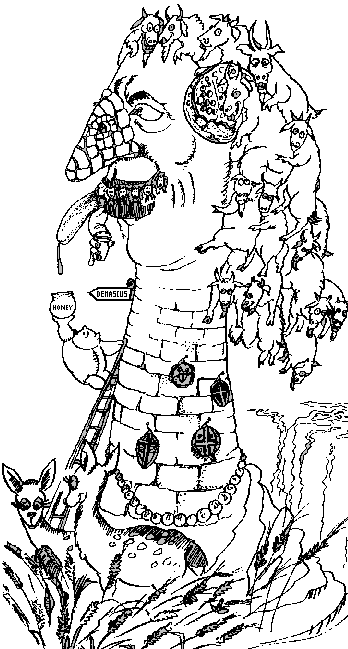|
|
|
Song of Songs is
a JEWISH LOVE SONG. This means that in order to interpret the meaning
of this book we need to understand two things...
|
|
We need to look at
the difference between the modern (western) mind and ancient Jewish thinking...
|
|
|
|
|
Therefore, in looking at the things mentioned in Song of Songs we must ask, not what they look like, but what is their function, nature, quality etc. This will give us the correct interpretation.
For example...how would you describe a pen ? How would a ancient Jew describe a pen ? Jewish thought goes, “I am not the pen...I cannot percieve what PEN is, therefore I must relate the PEN to me. How to use it ?” etc...
The Jewish mind looks
at IMPRESSIONS rather than IMAGES.... see
Song of Songs Chapters 4 & 7 . The
modern mind would see an UGLY WOMAN.....
 |
Song 4:1-5
1 Behold, you
are fair, my love! Behold, you are fair! You have dove's eyes behind your
veil. Your hair is like a flock of goats, going down from Mount Gilead.
Song 7:3-5
|
...the biblical mind would see the beautiful personality and heart of the woman.
(ii) Jewish Song /Poetry.
As this is a poetic song we must interpret the ‘heart’ of the song, not simply taking it literally. As mentioned above, we should interpret the meaning of the things mentioned (plants , animals, buildings) according to their function. The rest of scripture must also be used to determine the interpretations of frequently mentioned things (eg. Vine / Vineyard is a frequently use symbol of God’s people/ the Church in scripture).
Where there is a place name etc. it is useful to look at the original meaning (eg. Solomon = Prince of Peace).
(b) Levels Of Understanding.
As already mentioned,
there are two basic levels of interpreting this Song....
 |
|
If we interpret the Song of Songs this way we see it speaks of the need for pure, maturing love in relationships leading up to marriage and in marriage itself. It shows us how the husband and wife can compliment each other and be an effective witness for God.
This material only
touches on this level a few times in passing. There are many more excellent
resources for studying this aspect in more detail. The main emphasis of
this course is to reveal the prophetic nature of the Song of Solomon concerning,
particularly, Christ's relationship with His Bride, the Church.
 |
|
This is the allegorical interpretation. If we interpret this way we can see our relationship (as part of the Church) with Jesus. It speaks to us of the necessity of a devotional life, and through stages brings us to a revelation of Christ as ‘Lord of the Harvest’, or the ‘Master of the Multitudes.’ (Songs 8:11, Baal Hamon can be translated as either) - see Matt 13:39.
This is in agreement
with the whole of scripture which refers to God’s people as the Bride,
and God (Jesus in N.T) as the Groom.
| O.T:
Isa 54:5,6; Jer 2:2; Ezek 16:8-14; Hos 2:16-20.
N.T: 2 Cor 11:2; Rev 19:7-9, 21:9.
Ephesians 5:22-29 beautifully combines
both these levels!
|
This level has several
layers! The Song is a prophetic portrayal of :
| LAYER 1: GOD'S
LOVE FOR ISRAEL AS HIS PEOPLE.
LAYER 2: JESUS' LOVE FOR HIS CHURCH (BODY OF CHRIST) LAYER 3: THE MESSIAH'S LOVE OF THE INDIVIDUAL. |
We will be particularly focusing on LAYER 3, our individual relationship with Jesus and His wooing of us into the harvest fields. However, certain sections will particularly be looking at Christ's dealings with the Church as a whole (as that is the main thrust of the passage being dealt with).
God still has a special relationship with the natural Israel (the author does not hold to the belief that the Church has replaced Israel and become the Spiritual Israel) and they are very much on His heart, but this material will not look into this layer of interpretation.
 (c) How The Song Is Divided.
(c) How The Song Is Divided.
The Song is divided into stages of love by a phrase that contains “I charge You’” in all cases. Mostly the phrase will be something like “I charge you, O daughters of Jerusalem, by the gazelles or the does of the field, do not stir up nor awaken love until it pleases.”( 2:7; 3:5; 5:8; 8:4 - five stages of love.)
This phrase shows
us that we cannot force someone into a deeper love relationship either
on a human level , or with God. Each person has to go through each stage
at the pace that love dictates! (Look at the words used for further insights).
| The stages of love
can be
called the following (see to the right).... Each stage denotes
a particular
|
STAGE
1: (
1:1-2:7) : Premature Love.
STAGE 2: ( 2:8-3:5) : Possessive Love. STAGE 3: ( 3:6-5:8) : Painful Love. STAGE 4: ( 5:9-8:4) : Powerful Love. STAGE 5: ( 8:5-8:14): Perfecting Love. |
We see how the Beloved (man) constantly draws the Lover (woman) out of her comfort zone into the mountains and fields (which speaks of her calling in this world).
Many Christians have seen this book as one of the greatest missionary challenges in the Bible. Hudson Taylor wrote that Song of Songs was ‘..the strength of my life and missionary endeavour.”